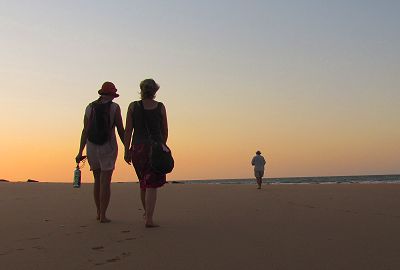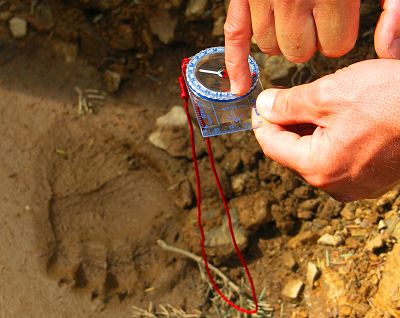Voluntourism, volunteering, citizen science and wildlife conservation & research - can laypeople really be of help to serious research & conservation projects?
Our executive director Dr. Matthias Hammer makes a case for volunteers in conservation
Given the strong and often justified criticisms levied at volunteering, the question of whether laypeople can be of any use in nature conservation is warranted. The answer, however, is simple: yes, absolutely - if the project is set up properly! For much of biological data collection consists of simple tasks and with a little training anyone can go on a wildlife conservation holiday, become a citizen scientist and help to collect much-needed information. Hard data form the core of all scientific arguments, but someone has to collect the information and this is often labour-intensive and, within a well-designed animal volunteer holiday, can therefore be perfect for laypeople / citizen scientist involvement.
Stamp collecting foot soldiers

Stamp collecting in Brazil
I call this my stamp collecting argument for wildlife research volunteers. What I mean by this is that very often effective conservation is based on a large amount of data points, but that collecting those data points is also often both laborious as well as simple. Yet no technology exists to perform the required tasks. We simply cannot ask satellites to scan the Himalayas for snow leopards (although drones may be able to do this in the near future) and there is no technical solution for changing batteries and SD cards in the camera traps now involved in a vast number of surveys. So foot soldiers (in other words wildlife conservation volunteers) are needed for this. Research volunteers who can be trained easily within a day or two (see examples below) and then go out and collect useful data or, for example, cover the often large distances between camera traps in places that are likely to be remote and inaccessible. There is often no alternative to these boots on the ground. Of course these two examples are drawn from Biosphere Expeditions’ own projects, but there is more, independent evidence too: Going back as far as the 1960s, a great deal of literature has been produced highlighting the value of data collected by laypeople and the ideas, enthusiasm and hard work that they bring to the conservation world.
A study by Dr. Judy Foster-Smith and Dr. Stewart Evans of the University of Newcastle investigated the use of conservation volunteers to collect marine data in Cumbrae, Scotland. In this study the authors say that “much of this type of research is labour-intensive but technically straight-forward and volunteers could make significant contributions to it in the future”. And further, and remarkably, that “(data) generated from them (i.e. the conservation volunteer) were almost identical to those produced…… by an experienced scientist”!
A similar study in Oxfordshire’s Wytham woods by Dr. Chris Newman and Dr. Christina Buesching from Oxford University's Wildlife Conservation Research Unit yielded much the same conclusions: “…the study has found that people from all walks of life, with all levels of previous involvement with field ecology, from novice to expert, have something to offer to conservation… The results collected by the amateur naturalist teams proved very reliable when compared to more complex monitoring techniques used by professional researchers at Wytham.”
The Cumbrae study went on to highlight additional benefits laypeople participation in what for them was a volunteer holiday: “It should be noted that there are also educational benefits from the involvement of volunteers in scientific projects… it is a means of both raising people’s feelings of responsibility towards the environment and increasing their knowledge of environmental issues. An additional benefit is that wildlife volunteers may bring ‘new’ skills, experience, insights and enthusiasm to projects, and have the potential, therefore, of contributing significantly more to scientific investigations than simply providing a workforce to collect data.”
So if citizen science volunteers in conservation are undoubtedly useful, what then are the challenges?
Taking away jobs
Local people should do the jobs as salaried positions, rather than rich western volunteers who can afford to be unpaid. This is an argument that is sometimes made against volunteering in general and less often against conservation volunteering in particular - after all particpants are just on expedition holidays. There may be some merit in this, but again preparation and working with local communities is key. Projects that are hoisted on local communities without consultation are much more likely to fall foul of this point. Those projects that react to community demand are likely not only to not be taking jobs away, but actually generate jobs. For example by creating the need for labour and supplies to run a project’s logistics as is often the case on our more remote projects, for instance in the Tien Shan mountains of Kyrgyzstan or in the jungles of Sumatra, where without the help of local people and services, we could not run a volunteer expedition or its logistics. Moreover, and on conservation stamp collecting projects in particular, there is by and large no demand or funding for the kind of very particular and focused stamp-collecting labour outside narrow project dates, nor are there local people with the relevant training or background knowledge. Of course eventually and ideally, you would like the local community to acquire the relevant skills and take over. This is the reason why Biosphere Expeditions runs a placement programme, offering local people places on its expedition, as well as training and support. The kind of community-based monitoring that has emerged in the Maldives from this is exactly what we want to achieve through the placement programme: Local jobs and local caretaking of nature emerging out of projects that are created in consultation with community needs in the first place.
Sexy species

Sexy species sell
This, I believe, is the most valid criticism and the one I personally, as a trained biologist, struggle with most. It has been widely argued that the world has developed a very inefficient way of choosing which animals facing extinction to save, often favouring popular wildlife such as rhinos, koalas and big cats over the less well-known species, including Australia's blobfish, giant Gippsland worm, or the Pacific lamprey. A recent study has shown that around 80 mammal species including lions, tigers and pandas are used by international NGOs to raise funds for conservation, but almost no invertebrates are used in this way. The result, in the words of the authors, is that “if you are an obscure animal or plant in a remote place, you have less hope of getting conservation resources, even if you may be more genetically distinct – and contribute more to an ecosystem – than a charismatic species."
This is reflected in our expedition portfolio too, where our animal volunteer holidays are dominated by big, impressive, fluffy, furry and ‘cute’ species. There are the usual suspects: big cats, whales and dolphins, quokkas (‘cute’ small kangaroos) and coral reefs in warm, beautiful and exotic locations. Sexy sells. We tried the more mundane lammergeyer in the Pyrenees, but this did not attract enough people after an initial first-year flurry of loyal Biosphere conservation volunteers. So these days we, with a heavy heart, have to turn down interesting proposals for lack of species sex appeal, because I know that coconut crabs in Tanzania or scorpions in Burundi will simply not stand a chance against snow leopards of the Tien Shan mountains or Sumatran tigers.
And who can blame our committed citizen scientists for wanting to invest their time and money in something exciting and inspiring? And this is the crux of the matter and in fact how much of conservation works – by inspiring and motivating people through flagship species. Conservation organisations such as the IUCN (International Union for the Conservation of Nature) know this. For them one of the world’s rarest big mammals, the Sumatran rhino, has become a flagship species for safeguarding dozens of other threatened Indonesian rainforest animals in the handful of national parks that serve as the planet’s final strongholds for these rhinos. When looking a IUCN’s Red List of Threatened Species, dozens of other terrestrial vertebrates benefit from efforts in Sumatra. Two of these, the Sumatran elephant and Sumatran tiger, are certainly flagship species in their own right, but the list also includes a host of other significant amphibians, reptiles, birds and mammals. Five Vulnerable species, the king cobra - the world’s largest venomous snake – the crestless fireback pheasant, Asian small-clawed and smooth-coated otters and the binturong, inhabit all three national parks in which rangers patrol first and foremost to protect the rhino. Several threatened birds also benefit from the rhino protection programmes in two southern Sumatran national parks: the black partridge, blue-banded kingfisher, short-toed coucal, Storm’s stork, Sunda blue flycatcher, Sunda nightjar, Wallace’s hawk-eagle, and white-winged wood duck. It’s the long list of threatened mammals, however, that truly bolsters the status of the rhinos as flagship species. Among the more prominent taxa, with ranges that overlap those of forest-dwelling rhinos, are fruit bats, spiny and tree rats, flying squirrels, rabbits, civets, pangolins, mouse deer, sambar deer, tapir, Javan banteng, dholes (wild dogs), clouded leopards, Javan leopards, and a host of threatened primates – at least 10 species of tarsier, loris, leaf monkey, macaque, gibbon and siamang.
So flagship species fly the flag of conservation, serving as a conservation tool for the less sexy species, as they flutter in the wind, inspiring people and attracting funding, catalysing positive action and protecting whole habitats full of more ‘boring’ species in their wake. This is how I can justify our focus on charismatic animals to myself and the organisation.
And finally, money, of course
And there is a final point, mentioned in the last paragraph (and also dealt with in some detail in our 2015 Magazine): funding. With government and other public funding for conservation being slashed across the board, private wildlife conservation initiatives are becoming increasingly important, if not vital, in conservation. The funding and labour that conservation volunteers on expedition holidays provide every year to many projects across the globe enables them to keep chipping away at the block, year after year. This sets volunteer-based funding apart from many other funding sources, where very often support is limited to a few years at best. Yet generally government decision-making takes many years, not just a few, so efforts ebb away, breaking themselves on the big rocks of slow-moving bureaucracies that often have the economy and growth, but not conservation, on their agendas. This is certainly where volunteers for us have made all the difference. A number of our projects are now close to or over a decade in the running and it is often only through this persistence that they are able to achieve significant outcomes. Long may it continue.
Examples of citizen scientists collecting “their stamps” with Biosphere Expeditions
Example 1: Camera traps are ubiquitous tools in wildlife research these days. But for them to be effective you have to know where to put them, for example a wildlife trail, marking spot, water hole, etc. So first of all these kinds of places need to be found, which is one area where the multiple eyes and ears of citizen scientists, rather than a lone researcher scouring the landscape are useful. Once camera traps are set, they need to be checked regularly, batteries need to be changed, as do SD cards and there may be maintenance jobs too. All these skills can be learnt within a training session of a few hours. And once the camera traps have done their job, pictures need to be sifted through and sorted into categories, data entered, etc.

Example 2: Poaching of sea turtles and their eggs is a very big problem. There are some areas, such as in Costa Rica, where poaching was at 100% before direct conservation action. That means all turtles entering a beach were killed for their meat and/or shells and all eggs they laid were taken for human consumption. All-night beach patrols protecting the turtles and relocating their eggs to safe hatcheries, as well as round-the-clock guarding of those hatcheries have been critical in reducing poaching in many parts of the world and bringing sea turtle species back from the brink of extinction. But a large workforce is needed for the various shifts and tasks, which can all be learnt within a day of training. Volunteers, often working hand in hand with local people, have been vital in this.

Example 3: A bear track is unmistakable - even with no training you would probably know when you see one! A lone local scientist can only cover a small area each day, but a whole expedition team can survey a very large area and thereby provide the scientist with a much better picture of bear movements and numbers. And if for some reason (for example an unclear print on a hard substrate or a small juvenile print) volunteers are not sure whether they are looking at a bear track, they simply take a picture with a digital camera or a phone and ask the scientist at the end of the day. If it was a bear track, it will be entered into the datasheet; if it was not, the scientist will tell the citizen scientist (and the rest of the team) what they have found, helping everyone to build up their tracking knowledge.

See also
Biosphere Expeditions' top ten tips on choosing a wildlife volunteering experience
Bad news for genuine conservation efforts
Voluntourism is lambasted, but Biosphere Expeditions praised
Voluntourism is criticised, but Biosphere Expeditions selected as an ethical experience
Against the tide of bogus voluntourism
This article in the 2016 Biosphere Expeditions Magazine
